Impact of Employee Engagement Strategies: A Sainsbury's Study
VerifiedAdded on 2023/01/07
|12
|3782
|37
Report
AI Summary
This report investigates the impact of employee engagement strategies on business performance, focusing on Sainsbury's. It begins with an introduction to employee engagement, emphasizing its importance in retaining talent and achieving organizational goals. The report explores the concept of employee engagement, drawing from various models and research, and then examines different engagement strategies used by companies like Sainsbury's, such as flexible working hours, reward systems, 360-degree feedback, and training and development programs. The report also identifies the challenges companies face when implementing these strategies, including technological advancements, resource constraints, negative work environments, and communication issues. The methodology section highlights the use of a qualitative research approach to gather and analyze data, ensuring a comprehensive understanding of the subject. The report aims to provide insights into effective employee engagement practices and offer recommendations for overcoming challenges, ultimately contributing to improved business outcomes.

Management Research Methods
Paraphrase This Document
Need a fresh take? Get an instant paraphrase of this document with our AI Paraphraser

Table of Contents
INTRODUCTION......................................................................................................................3
Aim and Objectives................................................................................................................3
Literature Review...................................................................................................................4
Methodology..........................................................................................................................7
CONCLUSION..........................................................................................................................7
REFERENCES...........................................................................................................................9
INTRODUCTION......................................................................................................................3
Aim and Objectives................................................................................................................3
Literature Review...................................................................................................................4
Methodology..........................................................................................................................7
CONCLUSION..........................................................................................................................7
REFERENCES...........................................................................................................................9
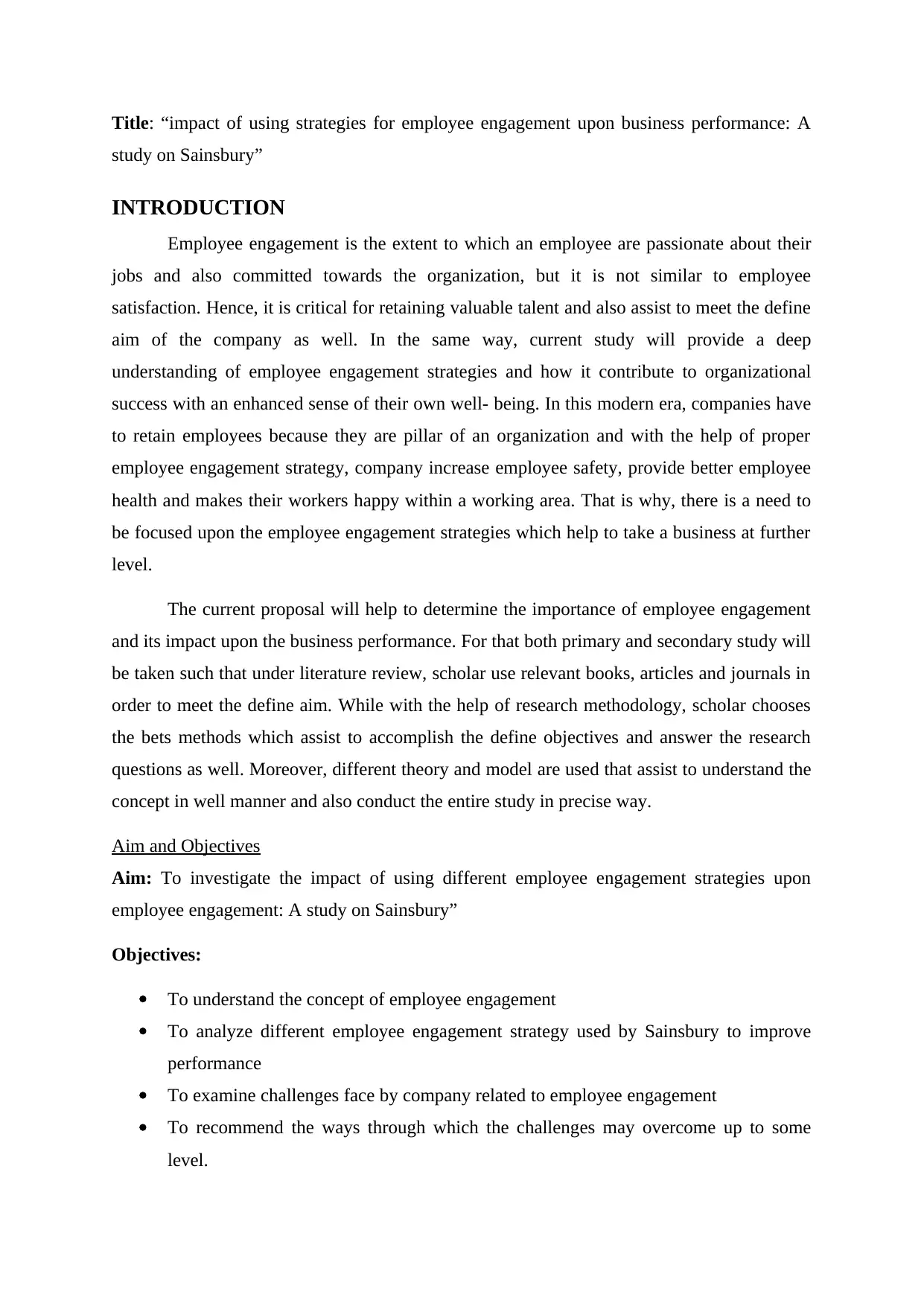
Title: “impact of using strategies for employee engagement upon business performance: A
study on Sainsbury”
INTRODUCTION
Employee engagement is the extent to which an employee are passionate about their
jobs and also committed towards the organization, but it is not similar to employee
satisfaction. Hence, it is critical for retaining valuable talent and also assist to meet the define
aim of the company as well. In the same way, current study will provide a deep
understanding of employee engagement strategies and how it contribute to organizational
success with an enhanced sense of their own well- being. In this modern era, companies have
to retain employees because they are pillar of an organization and with the help of proper
employee engagement strategy, company increase employee safety, provide better employee
health and makes their workers happy within a working area. That is why, there is a need to
be focused upon the employee engagement strategies which help to take a business at further
level.
The current proposal will help to determine the importance of employee engagement
and its impact upon the business performance. For that both primary and secondary study will
be taken such that under literature review, scholar use relevant books, articles and journals in
order to meet the define aim. While with the help of research methodology, scholar chooses
the bets methods which assist to accomplish the define objectives and answer the research
questions as well. Moreover, different theory and model are used that assist to understand the
concept in well manner and also conduct the entire study in precise way.
Aim and Objectives
Aim: To investigate the impact of using different employee engagement strategies upon
employee engagement: A study on Sainsbury”
Objectives:
To understand the concept of employee engagement
To analyze different employee engagement strategy used by Sainsbury to improve
performance
To examine challenges face by company related to employee engagement
To recommend the ways through which the challenges may overcome up to some
level.
study on Sainsbury”
INTRODUCTION
Employee engagement is the extent to which an employee are passionate about their
jobs and also committed towards the organization, but it is not similar to employee
satisfaction. Hence, it is critical for retaining valuable talent and also assist to meet the define
aim of the company as well. In the same way, current study will provide a deep
understanding of employee engagement strategies and how it contribute to organizational
success with an enhanced sense of their own well- being. In this modern era, companies have
to retain employees because they are pillar of an organization and with the help of proper
employee engagement strategy, company increase employee safety, provide better employee
health and makes their workers happy within a working area. That is why, there is a need to
be focused upon the employee engagement strategies which help to take a business at further
level.
The current proposal will help to determine the importance of employee engagement
and its impact upon the business performance. For that both primary and secondary study will
be taken such that under literature review, scholar use relevant books, articles and journals in
order to meet the define aim. While with the help of research methodology, scholar chooses
the bets methods which assist to accomplish the define objectives and answer the research
questions as well. Moreover, different theory and model are used that assist to understand the
concept in well manner and also conduct the entire study in precise way.
Aim and Objectives
Aim: To investigate the impact of using different employee engagement strategies upon
employee engagement: A study on Sainsbury”
Objectives:
To understand the concept of employee engagement
To analyze different employee engagement strategy used by Sainsbury to improve
performance
To examine challenges face by company related to employee engagement
To recommend the ways through which the challenges may overcome up to some
level.
⊘ This is a preview!⊘
Do you want full access?
Subscribe today to unlock all pages.

Trusted by 1+ million students worldwide
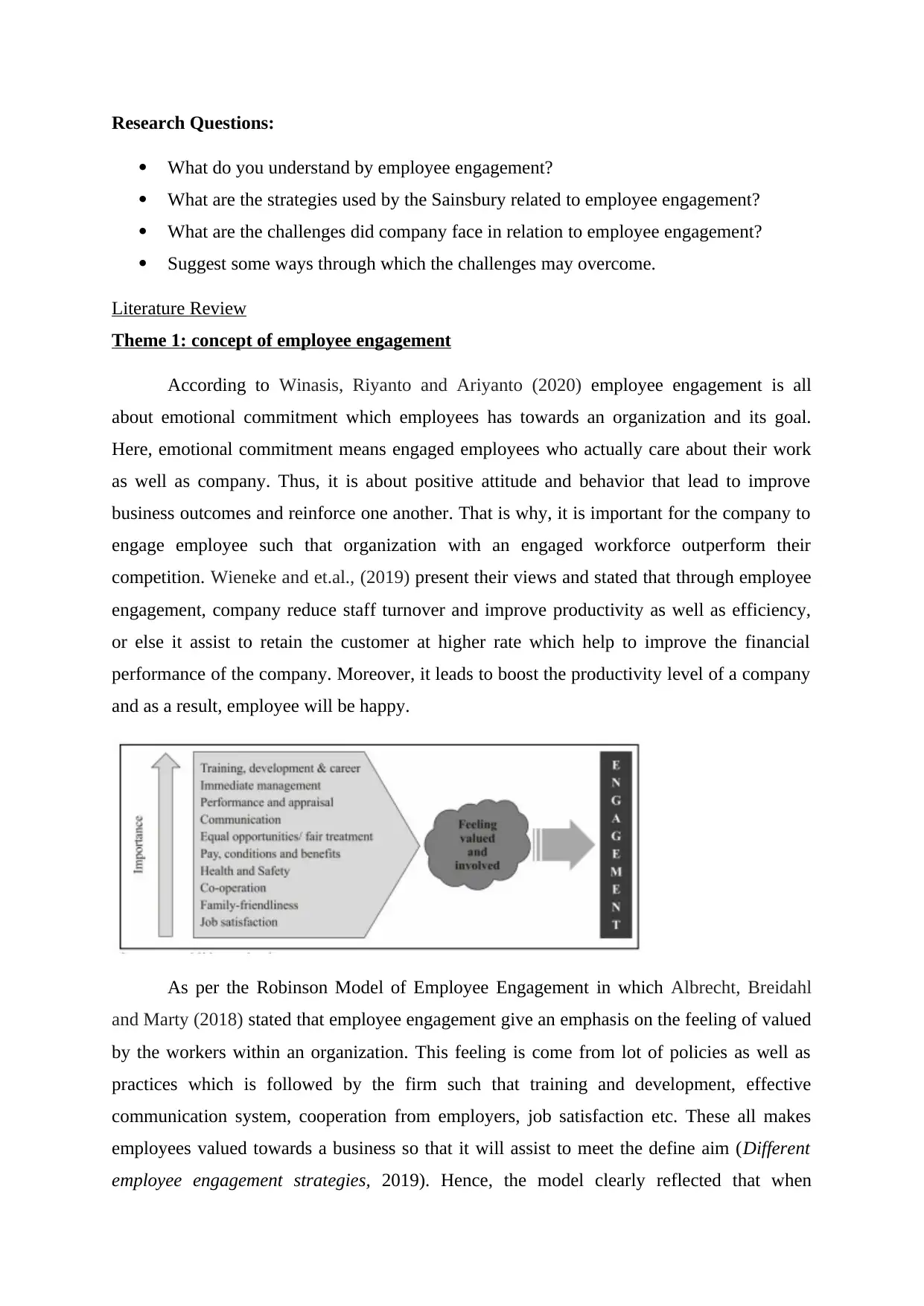
Research Questions:
What do you understand by employee engagement?
What are the strategies used by the Sainsbury related to employee engagement?
What are the challenges did company face in relation to employee engagement?
Suggest some ways through which the challenges may overcome.
Literature Review
Theme 1: concept of employee engagement
According to Winasis, Riyanto and Ariyanto (2020) employee engagement is all
about emotional commitment which employees has towards an organization and its goal.
Here, emotional commitment means engaged employees who actually care about their work
as well as company. Thus, it is about positive attitude and behavior that lead to improve
business outcomes and reinforce one another. That is why, it is important for the company to
engage employee such that organization with an engaged workforce outperform their
competition. Wieneke and et.al., (2019) present their views and stated that through employee
engagement, company reduce staff turnover and improve productivity as well as efficiency,
or else it assist to retain the customer at higher rate which help to improve the financial
performance of the company. Moreover, it leads to boost the productivity level of a company
and as a result, employee will be happy.
As per the Robinson Model of Employee Engagement in which Albrecht, Breidahl
and Marty (2018) stated that employee engagement give an emphasis on the feeling of valued
by the workers within an organization. This feeling is come from lot of policies as well as
practices which is followed by the firm such that training and development, effective
communication system, cooperation from employers, job satisfaction etc. These all makes
employees valued towards a business so that it will assist to meet the define aim (Different
employee engagement strategies, 2019). Hence, the model clearly reflected that when
What do you understand by employee engagement?
What are the strategies used by the Sainsbury related to employee engagement?
What are the challenges did company face in relation to employee engagement?
Suggest some ways through which the challenges may overcome.
Literature Review
Theme 1: concept of employee engagement
According to Winasis, Riyanto and Ariyanto (2020) employee engagement is all
about emotional commitment which employees has towards an organization and its goal.
Here, emotional commitment means engaged employees who actually care about their work
as well as company. Thus, it is about positive attitude and behavior that lead to improve
business outcomes and reinforce one another. That is why, it is important for the company to
engage employee such that organization with an engaged workforce outperform their
competition. Wieneke and et.al., (2019) present their views and stated that through employee
engagement, company reduce staff turnover and improve productivity as well as efficiency,
or else it assist to retain the customer at higher rate which help to improve the financial
performance of the company. Moreover, it leads to boost the productivity level of a company
and as a result, employee will be happy.
As per the Robinson Model of Employee Engagement in which Albrecht, Breidahl
and Marty (2018) stated that employee engagement give an emphasis on the feeling of valued
by the workers within an organization. This feeling is come from lot of policies as well as
practices which is followed by the firm such that training and development, effective
communication system, cooperation from employers, job satisfaction etc. These all makes
employees valued towards a business so that it will assist to meet the define aim (Different
employee engagement strategies, 2019). Hence, the model clearly reflected that when
Paraphrase This Document
Need a fresh take? Get an instant paraphrase of this document with our AI Paraphraser
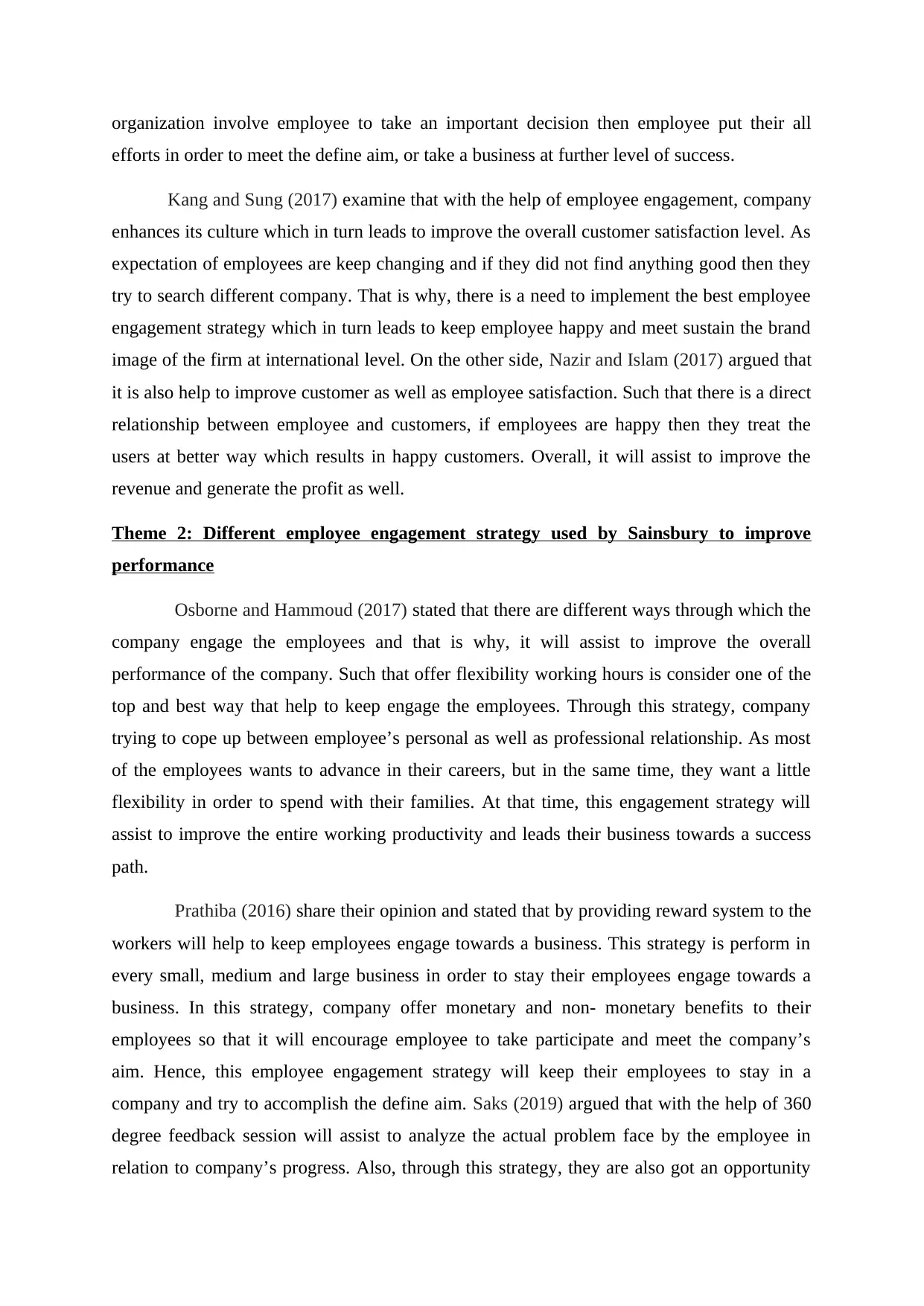
organization involve employee to take an important decision then employee put their all
efforts in order to meet the define aim, or take a business at further level of success.
Kang and Sung (2017) examine that with the help of employee engagement, company
enhances its culture which in turn leads to improve the overall customer satisfaction level. As
expectation of employees are keep changing and if they did not find anything good then they
try to search different company. That is why, there is a need to implement the best employee
engagement strategy which in turn leads to keep employee happy and meet sustain the brand
image of the firm at international level. On the other side, Nazir and Islam (2017) argued that
it is also help to improve customer as well as employee satisfaction. Such that there is a direct
relationship between employee and customers, if employees are happy then they treat the
users at better way which results in happy customers. Overall, it will assist to improve the
revenue and generate the profit as well.
Theme 2: Different employee engagement strategy used by Sainsbury to improve
performance
Osborne and Hammoud (2017) stated that there are different ways through which the
company engage the employees and that is why, it will assist to improve the overall
performance of the company. Such that offer flexibility working hours is consider one of the
top and best way that help to keep engage the employees. Through this strategy, company
trying to cope up between employee’s personal as well as professional relationship. As most
of the employees wants to advance in their careers, but in the same time, they want a little
flexibility in order to spend with their families. At that time, this engagement strategy will
assist to improve the entire working productivity and leads their business towards a success
path.
Prathiba (2016) share their opinion and stated that by providing reward system to the
workers will help to keep employees engage towards a business. This strategy is perform in
every small, medium and large business in order to stay their employees engage towards a
business. In this strategy, company offer monetary and non- monetary benefits to their
employees so that it will encourage employee to take participate and meet the company’s
aim. Hence, this employee engagement strategy will keep their employees to stay in a
company and try to accomplish the define aim. Saks (2019) argued that with the help of 360
degree feedback session will assist to analyze the actual problem face by the employee in
relation to company’s progress. Also, through this strategy, they are also got an opportunity
efforts in order to meet the define aim, or take a business at further level of success.
Kang and Sung (2017) examine that with the help of employee engagement, company
enhances its culture which in turn leads to improve the overall customer satisfaction level. As
expectation of employees are keep changing and if they did not find anything good then they
try to search different company. That is why, there is a need to implement the best employee
engagement strategy which in turn leads to keep employee happy and meet sustain the brand
image of the firm at international level. On the other side, Nazir and Islam (2017) argued that
it is also help to improve customer as well as employee satisfaction. Such that there is a direct
relationship between employee and customers, if employees are happy then they treat the
users at better way which results in happy customers. Overall, it will assist to improve the
revenue and generate the profit as well.
Theme 2: Different employee engagement strategy used by Sainsbury to improve
performance
Osborne and Hammoud (2017) stated that there are different ways through which the
company engage the employees and that is why, it will assist to improve the overall
performance of the company. Such that offer flexibility working hours is consider one of the
top and best way that help to keep engage the employees. Through this strategy, company
trying to cope up between employee’s personal as well as professional relationship. As most
of the employees wants to advance in their careers, but in the same time, they want a little
flexibility in order to spend with their families. At that time, this engagement strategy will
assist to improve the entire working productivity and leads their business towards a success
path.
Prathiba (2016) share their opinion and stated that by providing reward system to the
workers will help to keep employees engage towards a business. This strategy is perform in
every small, medium and large business in order to stay their employees engage towards a
business. In this strategy, company offer monetary and non- monetary benefits to their
employees so that it will encourage employee to take participate and meet the company’s
aim. Hence, this employee engagement strategy will keep their employees to stay in a
company and try to accomplish the define aim. Saks (2019) argued that with the help of 360
degree feedback session will assist to analyze the actual problem face by the employee in
relation to company’s progress. Also, through this strategy, they are also got an opportunity
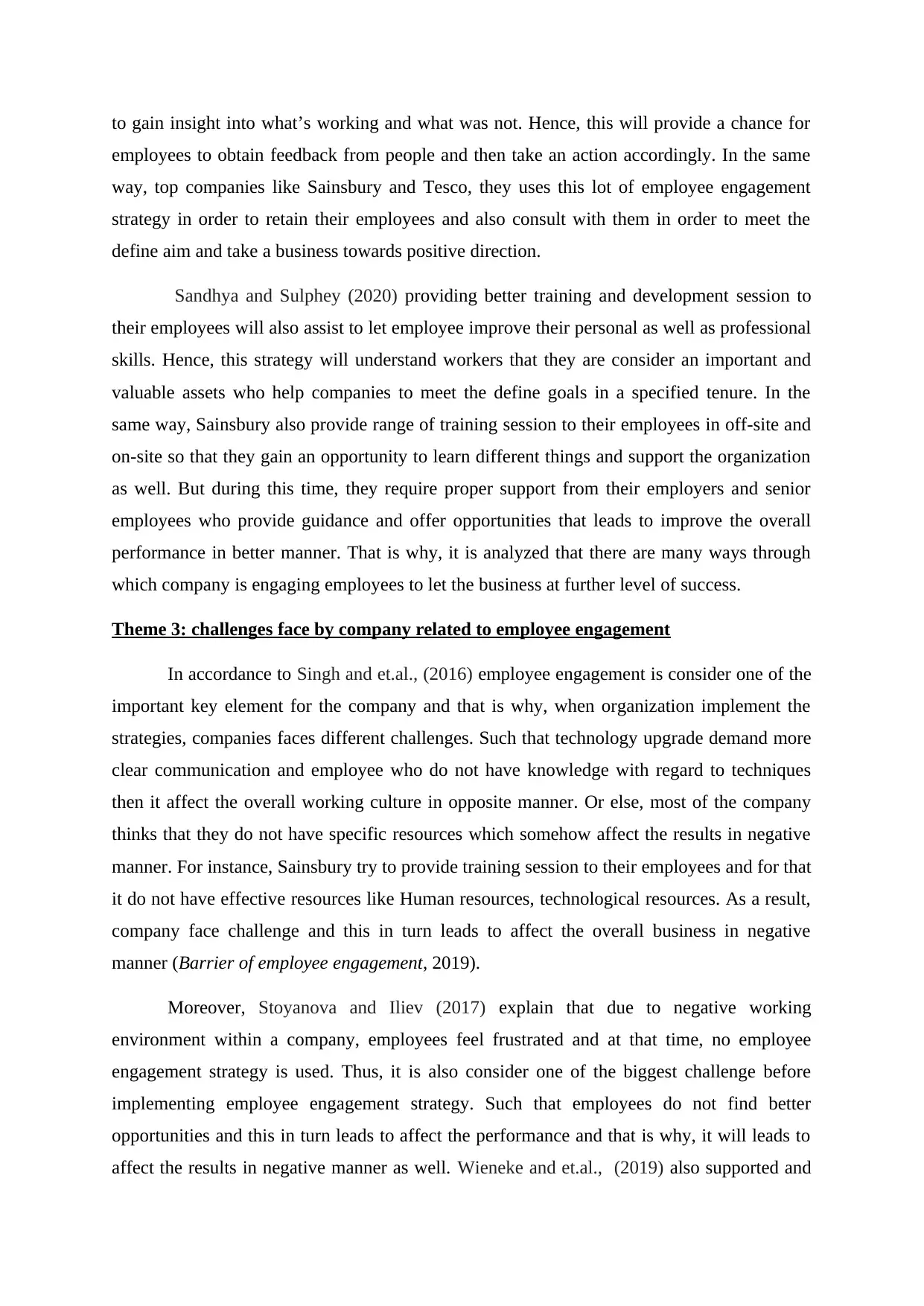
to gain insight into what’s working and what was not. Hence, this will provide a chance for
employees to obtain feedback from people and then take an action accordingly. In the same
way, top companies like Sainsbury and Tesco, they uses this lot of employee engagement
strategy in order to retain their employees and also consult with them in order to meet the
define aim and take a business towards positive direction.
Sandhya and Sulphey (2020) providing better training and development session to
their employees will also assist to let employee improve their personal as well as professional
skills. Hence, this strategy will understand workers that they are consider an important and
valuable assets who help companies to meet the define goals in a specified tenure. In the
same way, Sainsbury also provide range of training session to their employees in off-site and
on-site so that they gain an opportunity to learn different things and support the organization
as well. But during this time, they require proper support from their employers and senior
employees who provide guidance and offer opportunities that leads to improve the overall
performance in better manner. That is why, it is analyzed that there are many ways through
which company is engaging employees to let the business at further level of success.
Theme 3: challenges face by company related to employee engagement
In accordance to Singh and et.al., (2016) employee engagement is consider one of the
important key element for the company and that is why, when organization implement the
strategies, companies faces different challenges. Such that technology upgrade demand more
clear communication and employee who do not have knowledge with regard to techniques
then it affect the overall working culture in opposite manner. Or else, most of the company
thinks that they do not have specific resources which somehow affect the results in negative
manner. For instance, Sainsbury try to provide training session to their employees and for that
it do not have effective resources like Human resources, technological resources. As a result,
company face challenge and this in turn leads to affect the overall business in negative
manner (Barrier of employee engagement, 2019).
Moreover, Stoyanova and Iliev (2017) explain that due to negative working
environment within a company, employees feel frustrated and at that time, no employee
engagement strategy is used. Thus, it is also consider one of the biggest challenge before
implementing employee engagement strategy. Such that employees do not find better
opportunities and this in turn leads to affect the performance and that is why, it will leads to
affect the results in negative manner as well. Wieneke and et.al., (2019) also supported and
employees to obtain feedback from people and then take an action accordingly. In the same
way, top companies like Sainsbury and Tesco, they uses this lot of employee engagement
strategy in order to retain their employees and also consult with them in order to meet the
define aim and take a business towards positive direction.
Sandhya and Sulphey (2020) providing better training and development session to
their employees will also assist to let employee improve their personal as well as professional
skills. Hence, this strategy will understand workers that they are consider an important and
valuable assets who help companies to meet the define goals in a specified tenure. In the
same way, Sainsbury also provide range of training session to their employees in off-site and
on-site so that they gain an opportunity to learn different things and support the organization
as well. But during this time, they require proper support from their employers and senior
employees who provide guidance and offer opportunities that leads to improve the overall
performance in better manner. That is why, it is analyzed that there are many ways through
which company is engaging employees to let the business at further level of success.
Theme 3: challenges face by company related to employee engagement
In accordance to Singh and et.al., (2016) employee engagement is consider one of the
important key element for the company and that is why, when organization implement the
strategies, companies faces different challenges. Such that technology upgrade demand more
clear communication and employee who do not have knowledge with regard to techniques
then it affect the overall working culture in opposite manner. Or else, most of the company
thinks that they do not have specific resources which somehow affect the results in negative
manner. For instance, Sainsbury try to provide training session to their employees and for that
it do not have effective resources like Human resources, technological resources. As a result,
company face challenge and this in turn leads to affect the overall business in negative
manner (Barrier of employee engagement, 2019).
Moreover, Stoyanova and Iliev (2017) explain that due to negative working
environment within a company, employees feel frustrated and at that time, no employee
engagement strategy is used. Thus, it is also consider one of the biggest challenge before
implementing employee engagement strategy. Such that employees do not find better
opportunities and this in turn leads to affect the performance and that is why, it will leads to
affect the results in negative manner as well. Wieneke and et.al., (2019) also supported and
⊘ This is a preview!⊘
Do you want full access?
Subscribe today to unlock all pages.

Trusted by 1+ million students worldwide
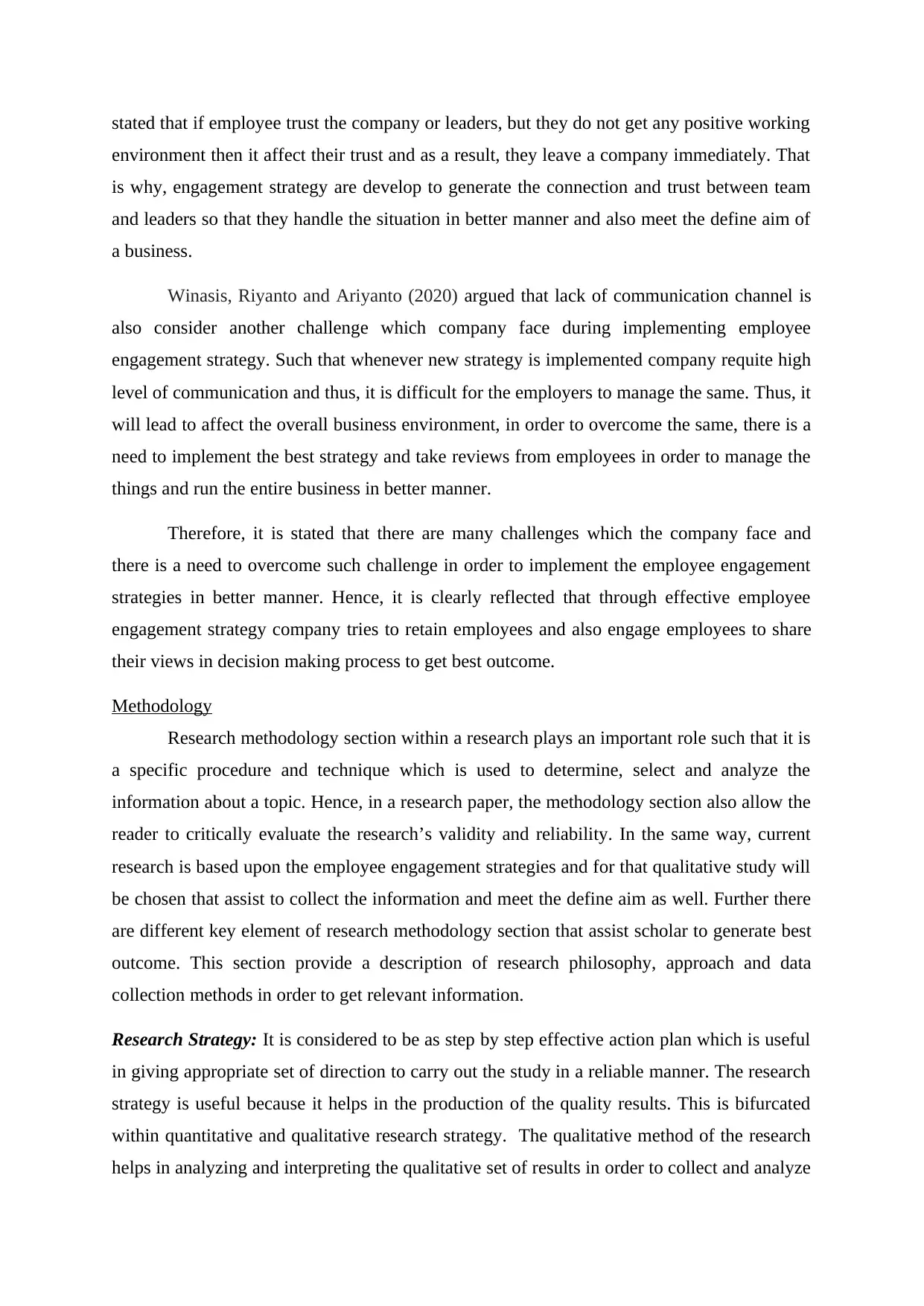
stated that if employee trust the company or leaders, but they do not get any positive working
environment then it affect their trust and as a result, they leave a company immediately. That
is why, engagement strategy are develop to generate the connection and trust between team
and leaders so that they handle the situation in better manner and also meet the define aim of
a business.
Winasis, Riyanto and Ariyanto (2020) argued that lack of communication channel is
also consider another challenge which company face during implementing employee
engagement strategy. Such that whenever new strategy is implemented company requite high
level of communication and thus, it is difficult for the employers to manage the same. Thus, it
will lead to affect the overall business environment, in order to overcome the same, there is a
need to implement the best strategy and take reviews from employees in order to manage the
things and run the entire business in better manner.
Therefore, it is stated that there are many challenges which the company face and
there is a need to overcome such challenge in order to implement the employee engagement
strategies in better manner. Hence, it is clearly reflected that through effective employee
engagement strategy company tries to retain employees and also engage employees to share
their views in decision making process to get best outcome.
Methodology
Research methodology section within a research plays an important role such that it is
a specific procedure and technique which is used to determine, select and analyze the
information about a topic. Hence, in a research paper, the methodology section also allow the
reader to critically evaluate the research’s validity and reliability. In the same way, current
research is based upon the employee engagement strategies and for that qualitative study will
be chosen that assist to collect the information and meet the define aim as well. Further there
are different key element of research methodology section that assist scholar to generate best
outcome. This section provide a description of research philosophy, approach and data
collection methods in order to get relevant information.
Research Strategy: It is considered to be as step by step effective action plan which is useful
in giving appropriate set of direction to carry out the study in a reliable manner. The research
strategy is useful because it helps in the production of the quality results. This is bifurcated
within quantitative and qualitative research strategy. The qualitative method of the research
helps in analyzing and interpreting the qualitative set of results in order to collect and analyze
environment then it affect their trust and as a result, they leave a company immediately. That
is why, engagement strategy are develop to generate the connection and trust between team
and leaders so that they handle the situation in better manner and also meet the define aim of
a business.
Winasis, Riyanto and Ariyanto (2020) argued that lack of communication channel is
also consider another challenge which company face during implementing employee
engagement strategy. Such that whenever new strategy is implemented company requite high
level of communication and thus, it is difficult for the employers to manage the same. Thus, it
will lead to affect the overall business environment, in order to overcome the same, there is a
need to implement the best strategy and take reviews from employees in order to manage the
things and run the entire business in better manner.
Therefore, it is stated that there are many challenges which the company face and
there is a need to overcome such challenge in order to implement the employee engagement
strategies in better manner. Hence, it is clearly reflected that through effective employee
engagement strategy company tries to retain employees and also engage employees to share
their views in decision making process to get best outcome.
Methodology
Research methodology section within a research plays an important role such that it is
a specific procedure and technique which is used to determine, select and analyze the
information about a topic. Hence, in a research paper, the methodology section also allow the
reader to critically evaluate the research’s validity and reliability. In the same way, current
research is based upon the employee engagement strategies and for that qualitative study will
be chosen that assist to collect the information and meet the define aim as well. Further there
are different key element of research methodology section that assist scholar to generate best
outcome. This section provide a description of research philosophy, approach and data
collection methods in order to get relevant information.
Research Strategy: It is considered to be as step by step effective action plan which is useful
in giving appropriate set of direction to carry out the study in a reliable manner. The research
strategy is useful because it helps in the production of the quality results. This is bifurcated
within quantitative and qualitative research strategy. The qualitative method of the research
helps in analyzing and interpreting the qualitative set of results in order to collect and analyze
Paraphrase This Document
Need a fresh take? Get an instant paraphrase of this document with our AI Paraphraser
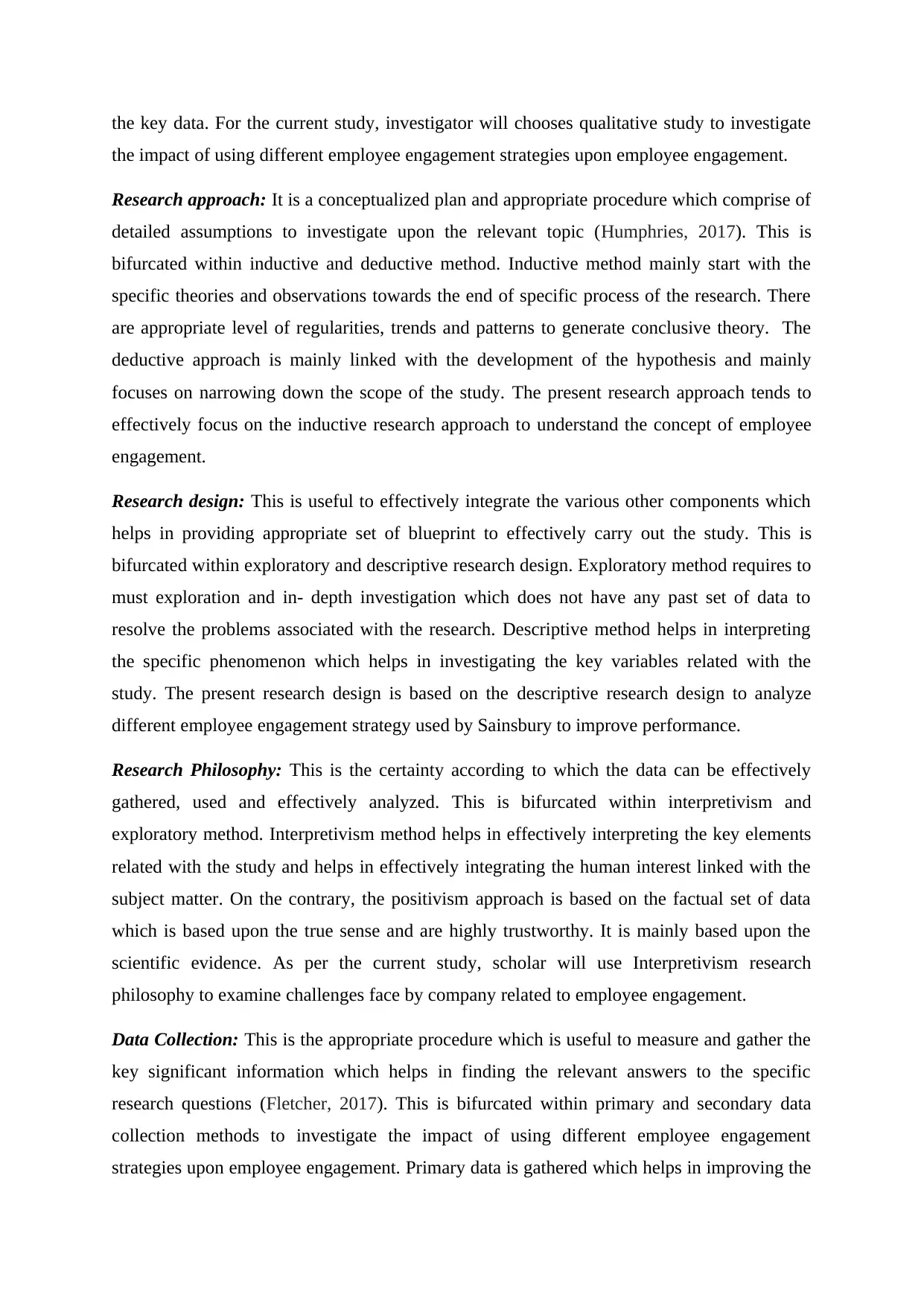
the key data. For the current study, investigator will chooses qualitative study to investigate
the impact of using different employee engagement strategies upon employee engagement.
Research approach: It is a conceptualized plan and appropriate procedure which comprise of
detailed assumptions to investigate upon the relevant topic (Humphries, 2017). This is
bifurcated within inductive and deductive method. Inductive method mainly start with the
specific theories and observations towards the end of specific process of the research. There
are appropriate level of regularities, trends and patterns to generate conclusive theory. The
deductive approach is mainly linked with the development of the hypothesis and mainly
focuses on narrowing down the scope of the study. The present research approach tends to
effectively focus on the inductive research approach to understand the concept of employee
engagement.
Research design: This is useful to effectively integrate the various other components which
helps in providing appropriate set of blueprint to effectively carry out the study. This is
bifurcated within exploratory and descriptive research design. Exploratory method requires to
must exploration and in- depth investigation which does not have any past set of data to
resolve the problems associated with the research. Descriptive method helps in interpreting
the specific phenomenon which helps in investigating the key variables related with the
study. The present research design is based on the descriptive research design to analyze
different employee engagement strategy used by Sainsbury to improve performance.
Research Philosophy: This is the certainty according to which the data can be effectively
gathered, used and effectively analyzed. This is bifurcated within interpretivism and
exploratory method. Interpretivism method helps in effectively interpreting the key elements
related with the study and helps in effectively integrating the human interest linked with the
subject matter. On the contrary, the positivism approach is based on the factual set of data
which is based upon the true sense and are highly trustworthy. It is mainly based upon the
scientific evidence. As per the current study, scholar will use Interpretivism research
philosophy to examine challenges face by company related to employee engagement.
Data Collection: This is the appropriate procedure which is useful to measure and gather the
key significant information which helps in finding the relevant answers to the specific
research questions (Fletcher, 2017). This is bifurcated within primary and secondary data
collection methods to investigate the impact of using different employee engagement
strategies upon employee engagement. Primary data is gathered which helps in improving the
the impact of using different employee engagement strategies upon employee engagement.
Research approach: It is a conceptualized plan and appropriate procedure which comprise of
detailed assumptions to investigate upon the relevant topic (Humphries, 2017). This is
bifurcated within inductive and deductive method. Inductive method mainly start with the
specific theories and observations towards the end of specific process of the research. There
are appropriate level of regularities, trends and patterns to generate conclusive theory. The
deductive approach is mainly linked with the development of the hypothesis and mainly
focuses on narrowing down the scope of the study. The present research approach tends to
effectively focus on the inductive research approach to understand the concept of employee
engagement.
Research design: This is useful to effectively integrate the various other components which
helps in providing appropriate set of blueprint to effectively carry out the study. This is
bifurcated within exploratory and descriptive research design. Exploratory method requires to
must exploration and in- depth investigation which does not have any past set of data to
resolve the problems associated with the research. Descriptive method helps in interpreting
the specific phenomenon which helps in investigating the key variables related with the
study. The present research design is based on the descriptive research design to analyze
different employee engagement strategy used by Sainsbury to improve performance.
Research Philosophy: This is the certainty according to which the data can be effectively
gathered, used and effectively analyzed. This is bifurcated within interpretivism and
exploratory method. Interpretivism method helps in effectively interpreting the key elements
related with the study and helps in effectively integrating the human interest linked with the
subject matter. On the contrary, the positivism approach is based on the factual set of data
which is based upon the true sense and are highly trustworthy. It is mainly based upon the
scientific evidence. As per the current study, scholar will use Interpretivism research
philosophy to examine challenges face by company related to employee engagement.
Data Collection: This is the appropriate procedure which is useful to measure and gather the
key significant information which helps in finding the relevant answers to the specific
research questions (Fletcher, 2017). This is bifurcated within primary and secondary data
collection methods to investigate the impact of using different employee engagement
strategies upon employee engagement. Primary data is gathered which helps in improving the
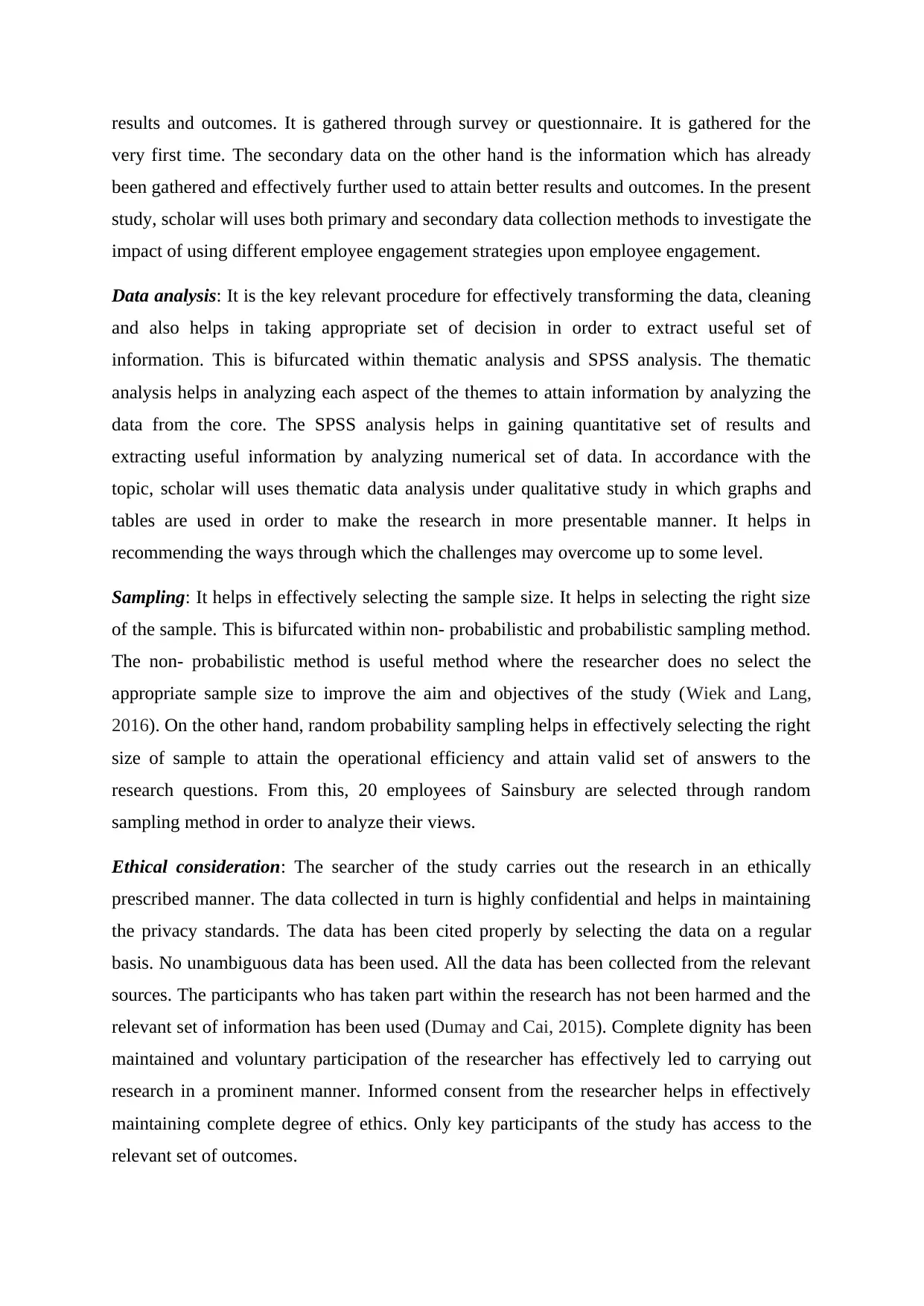
results and outcomes. It is gathered through survey or questionnaire. It is gathered for the
very first time. The secondary data on the other hand is the information which has already
been gathered and effectively further used to attain better results and outcomes. In the present
study, scholar will uses both primary and secondary data collection methods to investigate the
impact of using different employee engagement strategies upon employee engagement.
Data analysis: It is the key relevant procedure for effectively transforming the data, cleaning
and also helps in taking appropriate set of decision in order to extract useful set of
information. This is bifurcated within thematic analysis and SPSS analysis. The thematic
analysis helps in analyzing each aspect of the themes to attain information by analyzing the
data from the core. The SPSS analysis helps in gaining quantitative set of results and
extracting useful information by analyzing numerical set of data. In accordance with the
topic, scholar will uses thematic data analysis under qualitative study in which graphs and
tables are used in order to make the research in more presentable manner. It helps in
recommending the ways through which the challenges may overcome up to some level.
Sampling: It helps in effectively selecting the sample size. It helps in selecting the right size
of the sample. This is bifurcated within non- probabilistic and probabilistic sampling method.
The non- probabilistic method is useful method where the researcher does no select the
appropriate sample size to improve the aim and objectives of the study (Wiek and Lang,
2016). On the other hand, random probability sampling helps in effectively selecting the right
size of sample to attain the operational efficiency and attain valid set of answers to the
research questions. From this, 20 employees of Sainsbury are selected through random
sampling method in order to analyze their views.
Ethical consideration: The searcher of the study carries out the research in an ethically
prescribed manner. The data collected in turn is highly confidential and helps in maintaining
the privacy standards. The data has been cited properly by selecting the data on a regular
basis. No unambiguous data has been used. All the data has been collected from the relevant
sources. The participants who has taken part within the research has not been harmed and the
relevant set of information has been used (Dumay and Cai, 2015). Complete dignity has been
maintained and voluntary participation of the researcher has effectively led to carrying out
research in a prominent manner. Informed consent from the researcher helps in effectively
maintaining complete degree of ethics. Only key participants of the study has access to the
relevant set of outcomes.
very first time. The secondary data on the other hand is the information which has already
been gathered and effectively further used to attain better results and outcomes. In the present
study, scholar will uses both primary and secondary data collection methods to investigate the
impact of using different employee engagement strategies upon employee engagement.
Data analysis: It is the key relevant procedure for effectively transforming the data, cleaning
and also helps in taking appropriate set of decision in order to extract useful set of
information. This is bifurcated within thematic analysis and SPSS analysis. The thematic
analysis helps in analyzing each aspect of the themes to attain information by analyzing the
data from the core. The SPSS analysis helps in gaining quantitative set of results and
extracting useful information by analyzing numerical set of data. In accordance with the
topic, scholar will uses thematic data analysis under qualitative study in which graphs and
tables are used in order to make the research in more presentable manner. It helps in
recommending the ways through which the challenges may overcome up to some level.
Sampling: It helps in effectively selecting the sample size. It helps in selecting the right size
of the sample. This is bifurcated within non- probabilistic and probabilistic sampling method.
The non- probabilistic method is useful method where the researcher does no select the
appropriate sample size to improve the aim and objectives of the study (Wiek and Lang,
2016). On the other hand, random probability sampling helps in effectively selecting the right
size of sample to attain the operational efficiency and attain valid set of answers to the
research questions. From this, 20 employees of Sainsbury are selected through random
sampling method in order to analyze their views.
Ethical consideration: The searcher of the study carries out the research in an ethically
prescribed manner. The data collected in turn is highly confidential and helps in maintaining
the privacy standards. The data has been cited properly by selecting the data on a regular
basis. No unambiguous data has been used. All the data has been collected from the relevant
sources. The participants who has taken part within the research has not been harmed and the
relevant set of information has been used (Dumay and Cai, 2015). Complete dignity has been
maintained and voluntary participation of the researcher has effectively led to carrying out
research in a prominent manner. Informed consent from the researcher helps in effectively
maintaining complete degree of ethics. Only key participants of the study has access to the
relevant set of outcomes.
⊘ This is a preview!⊘
Do you want full access?
Subscribe today to unlock all pages.

Trusted by 1+ million students worldwide
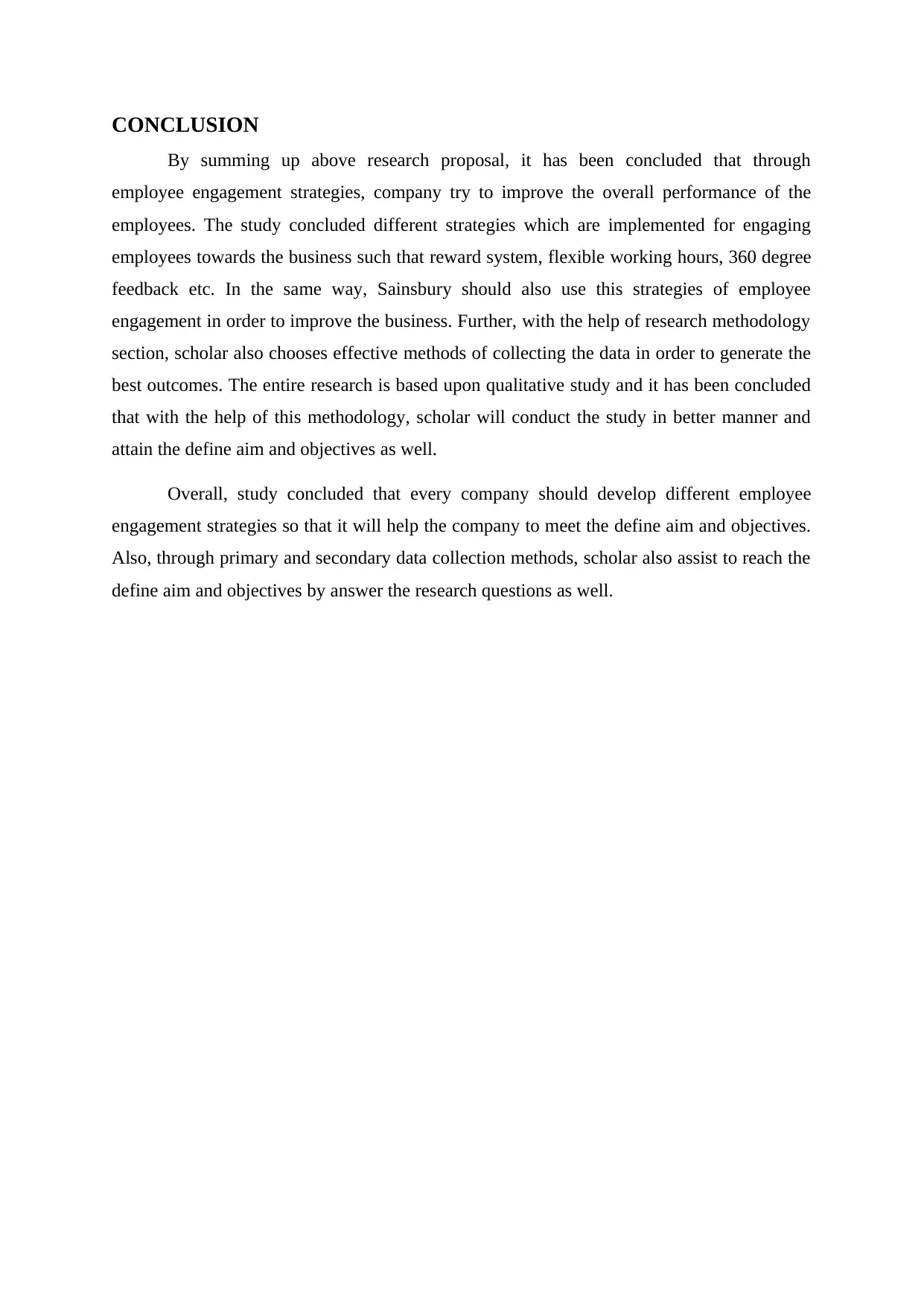
CONCLUSION
By summing up above research proposal, it has been concluded that through
employee engagement strategies, company try to improve the overall performance of the
employees. The study concluded different strategies which are implemented for engaging
employees towards the business such that reward system, flexible working hours, 360 degree
feedback etc. In the same way, Sainsbury should also use this strategies of employee
engagement in order to improve the business. Further, with the help of research methodology
section, scholar also chooses effective methods of collecting the data in order to generate the
best outcomes. The entire research is based upon qualitative study and it has been concluded
that with the help of this methodology, scholar will conduct the study in better manner and
attain the define aim and objectives as well.
Overall, study concluded that every company should develop different employee
engagement strategies so that it will help the company to meet the define aim and objectives.
Also, through primary and secondary data collection methods, scholar also assist to reach the
define aim and objectives by answer the research questions as well.
By summing up above research proposal, it has been concluded that through
employee engagement strategies, company try to improve the overall performance of the
employees. The study concluded different strategies which are implemented for engaging
employees towards the business such that reward system, flexible working hours, 360 degree
feedback etc. In the same way, Sainsbury should also use this strategies of employee
engagement in order to improve the business. Further, with the help of research methodology
section, scholar also chooses effective methods of collecting the data in order to generate the
best outcomes. The entire research is based upon qualitative study and it has been concluded
that with the help of this methodology, scholar will conduct the study in better manner and
attain the define aim and objectives as well.
Overall, study concluded that every company should develop different employee
engagement strategies so that it will help the company to meet the define aim and objectives.
Also, through primary and secondary data collection methods, scholar also assist to reach the
define aim and objectives by answer the research questions as well.
Paraphrase This Document
Need a fresh take? Get an instant paraphrase of this document with our AI Paraphraser
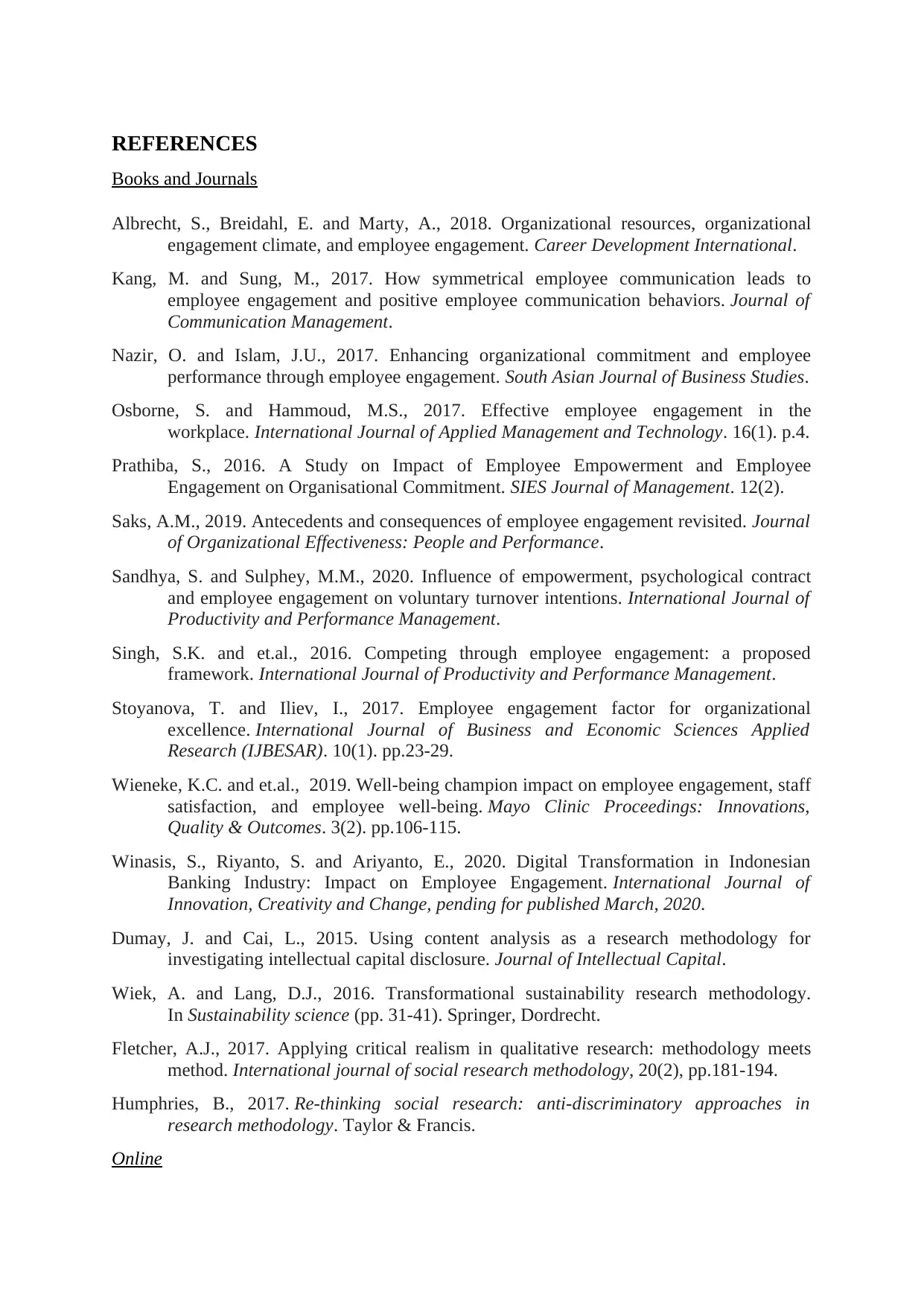
REFERENCES
Books and Journals
Albrecht, S., Breidahl, E. and Marty, A., 2018. Organizational resources, organizational
engagement climate, and employee engagement. Career Development International.
Kang, M. and Sung, M., 2017. How symmetrical employee communication leads to
employee engagement and positive employee communication behaviors. Journal of
Communication Management.
Nazir, O. and Islam, J.U., 2017. Enhancing organizational commitment and employee
performance through employee engagement. South Asian Journal of Business Studies.
Osborne, S. and Hammoud, M.S., 2017. Effective employee engagement in the
workplace. International Journal of Applied Management and Technology. 16(1). p.4.
Prathiba, S., 2016. A Study on Impact of Employee Empowerment and Employee
Engagement on Organisational Commitment. SIES Journal of Management. 12(2).
Saks, A.M., 2019. Antecedents and consequences of employee engagement revisited. Journal
of Organizational Effectiveness: People and Performance.
Sandhya, S. and Sulphey, M.M., 2020. Influence of empowerment, psychological contract
and employee engagement on voluntary turnover intentions. International Journal of
Productivity and Performance Management.
Singh, S.K. and et.al., 2016. Competing through employee engagement: a proposed
framework. International Journal of Productivity and Performance Management.
Stoyanova, T. and Iliev, I., 2017. Employee engagement factor for organizational
excellence. International Journal of Business and Economic Sciences Applied
Research (IJBESAR). 10(1). pp.23-29.
Wieneke, K.C. and et.al., 2019. Well-being champion impact on employee engagement, staff
satisfaction, and employee well-being. Mayo Clinic Proceedings: Innovations,
Quality & Outcomes. 3(2). pp.106-115.
Winasis, S., Riyanto, S. and Ariyanto, E., 2020. Digital Transformation in Indonesian
Banking Industry: Impact on Employee Engagement. International Journal of
Innovation, Creativity and Change, pending for published March, 2020.
Dumay, J. and Cai, L., 2015. Using content analysis as a research methodology for
investigating intellectual capital disclosure. Journal of Intellectual Capital.
Wiek, A. and Lang, D.J., 2016. Transformational sustainability research methodology.
In Sustainability science (pp. 31-41). Springer, Dordrecht.
Fletcher, A.J., 2017. Applying critical realism in qualitative research: methodology meets
method. International journal of social research methodology, 20(2), pp.181-194.
Humphries, B., 2017. Re-thinking social research: anti-discriminatory approaches in
research methodology. Taylor & Francis.
Online
Books and Journals
Albrecht, S., Breidahl, E. and Marty, A., 2018. Organizational resources, organizational
engagement climate, and employee engagement. Career Development International.
Kang, M. and Sung, M., 2017. How symmetrical employee communication leads to
employee engagement and positive employee communication behaviors. Journal of
Communication Management.
Nazir, O. and Islam, J.U., 2017. Enhancing organizational commitment and employee
performance through employee engagement. South Asian Journal of Business Studies.
Osborne, S. and Hammoud, M.S., 2017. Effective employee engagement in the
workplace. International Journal of Applied Management and Technology. 16(1). p.4.
Prathiba, S., 2016. A Study on Impact of Employee Empowerment and Employee
Engagement on Organisational Commitment. SIES Journal of Management. 12(2).
Saks, A.M., 2019. Antecedents and consequences of employee engagement revisited. Journal
of Organizational Effectiveness: People and Performance.
Sandhya, S. and Sulphey, M.M., 2020. Influence of empowerment, psychological contract
and employee engagement on voluntary turnover intentions. International Journal of
Productivity and Performance Management.
Singh, S.K. and et.al., 2016. Competing through employee engagement: a proposed
framework. International Journal of Productivity and Performance Management.
Stoyanova, T. and Iliev, I., 2017. Employee engagement factor for organizational
excellence. International Journal of Business and Economic Sciences Applied
Research (IJBESAR). 10(1). pp.23-29.
Wieneke, K.C. and et.al., 2019. Well-being champion impact on employee engagement, staff
satisfaction, and employee well-being. Mayo Clinic Proceedings: Innovations,
Quality & Outcomes. 3(2). pp.106-115.
Winasis, S., Riyanto, S. and Ariyanto, E., 2020. Digital Transformation in Indonesian
Banking Industry: Impact on Employee Engagement. International Journal of
Innovation, Creativity and Change, pending for published March, 2020.
Dumay, J. and Cai, L., 2015. Using content analysis as a research methodology for
investigating intellectual capital disclosure. Journal of Intellectual Capital.
Wiek, A. and Lang, D.J., 2016. Transformational sustainability research methodology.
In Sustainability science (pp. 31-41). Springer, Dordrecht.
Fletcher, A.J., 2017. Applying critical realism in qualitative research: methodology meets
method. International journal of social research methodology, 20(2), pp.181-194.
Humphries, B., 2017. Re-thinking social research: anti-discriminatory approaches in
research methodology. Taylor & Francis.
Online

Different employee engagement strategies. 2019. [online]. Available through:
<https://sparkbay.com/en/culture-blog/employee-engagement-strategies-4>.
Barrier of employee engagement. 2019. [online]. Available through: <
https://www.energage.com/five-barriers-employee-engagement/>.
<https://sparkbay.com/en/culture-blog/employee-engagement-strategies-4>.
Barrier of employee engagement. 2019. [online]. Available through: <
https://www.energage.com/five-barriers-employee-engagement/>.
⊘ This is a preview!⊘
Do you want full access?
Subscribe today to unlock all pages.

Trusted by 1+ million students worldwide
1 out of 12
Related Documents
Your All-in-One AI-Powered Toolkit for Academic Success.
+13062052269
info@desklib.com
Available 24*7 on WhatsApp / Email
![[object Object]](/_next/static/media/star-bottom.7253800d.svg)
Unlock your academic potential
Copyright © 2020–2025 A2Z Services. All Rights Reserved. Developed and managed by ZUCOL.




